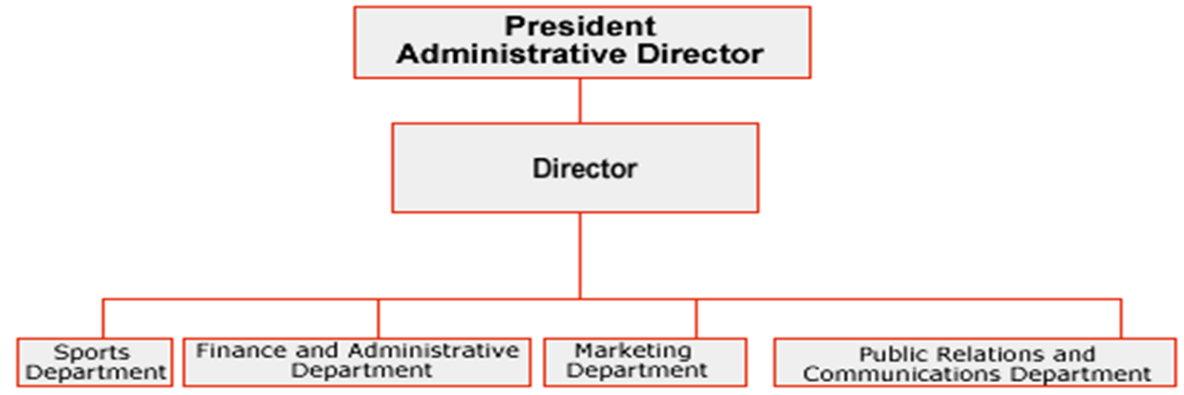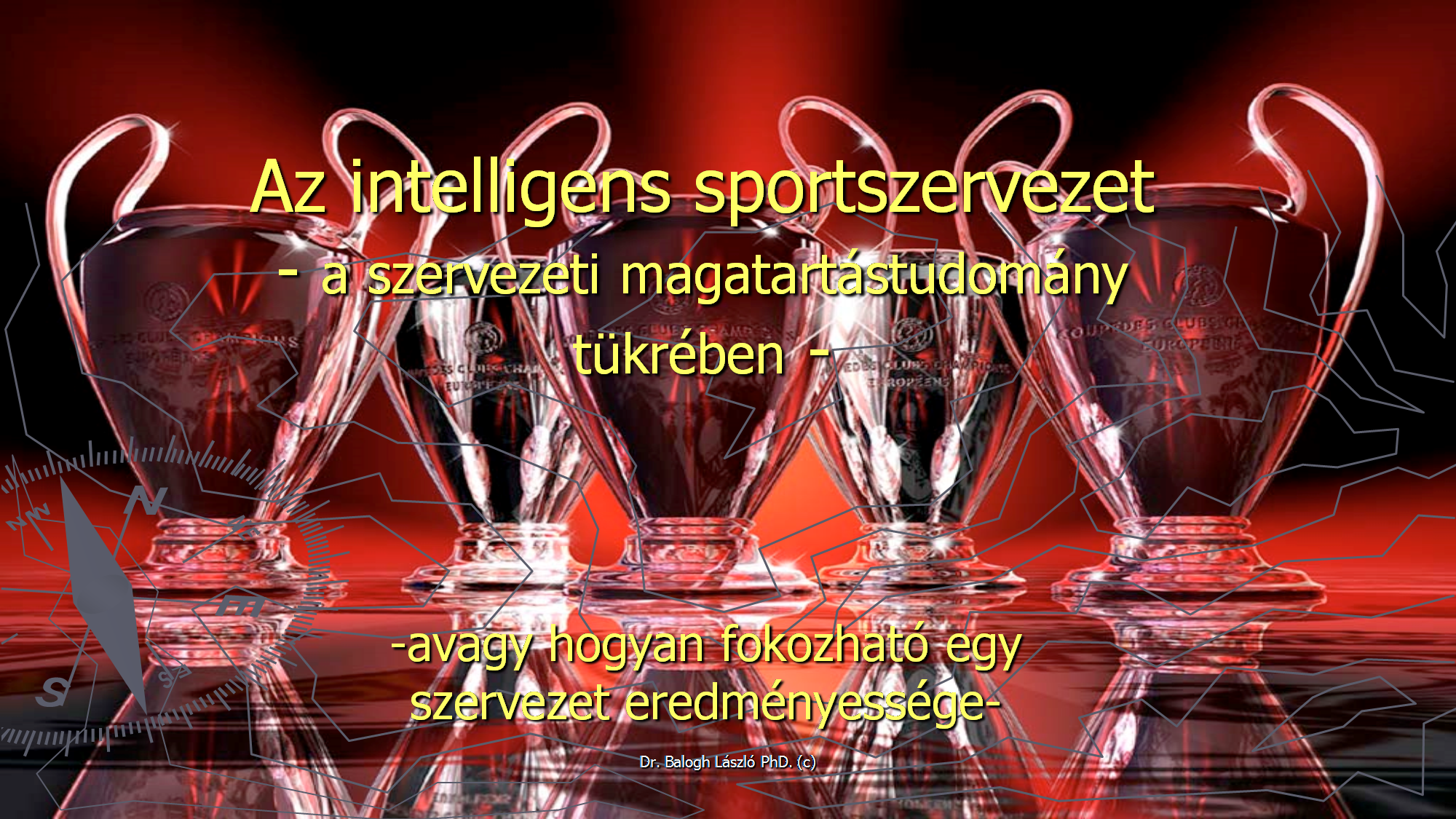Main types of organisations
The word organisation is frequently used both in the literature and everyday language. Our lives are dominated by organisations such as families, schools, workplaces or sports organisations, etc. The following expressions are also often used interchangeably: sports organisation, sports association, sports club, and sports team. Depending on the framework we apply, such usage might actually be correct in a wide range of cases. However, the meaning of sports laws, sports associations, sports organisations, and sports foundations/companies is approached in a different way by legal experts and researchers of organisational science.
Definitions also differ according to the branches within the latter field, but it is possible to detect several common features. An organisation is a unit of people, tools, and resources structured in order to pursue collective goals by means of balanced and coordinated effort and a functional division of work, having a hierarchical structure and continuously adjusting to the changing circumstances within and outside of it.
According to Klein (2007), there are 5 distinct strategic elements that fundamentally determine the workings of organisations. (1) Content, i.e. all the resources together, (2) structure, i.e. the structure, hierarchy, units, etc. of organisations that can be represented by using an organogram, (3) communication system, which enables members to receive the appropriate information in the appropriate time and place, (4) monitoring/controlling/supervision is also required to be able to find the most suitable place to carry out goals, and (5) decision-making, which is the key component of all, as the previous four elements may be present on a higher level, but without making correct decisions, or making no decisions at all, organisations may not function properly.
We may also take the view of an organisation as a living being, an organism, being composed of the parts of such unit, which can be human resources, instruments or financial resources. Darwin’s idea of a successful organism might also apply in the case of organisations too, more precisely, we could say that only flexible ones can flourish. These are able to adapt to new circumstances easily and make proper decisions.
Organisations can be characterised in many different ways depending on their goals and profiles.
As mentioned above, an organisation is established in order to work towards certain goals, which might be long-term, for example, maintaining a sports club for 100 years, while there can also be short-term goals such as founding a project organisation for a period of a year. Setting realistic goals related to the time of functioning, short-, medium- or long-term ones, is crucial in each and every case. These features appear in the strategies of an organisation, containing the goals to be achieved. In order to see how well an organisation is functioning, continuous monitoring/controlling is required, and certain processes should be modified on the basis of any feedback received. There are general goals that organisations have; these are included in the “mission statement” of an establishment, detailing why and with what purpose it was founded. There are operative goals too, describing the concrete steps to be taken for a certain period of time or related to an event (e.g. a programme or a competition). Moreover, hidden goals might also exist, which are not manifested but affect the workings of organisations. To sum up, the main functions of goals can be described as follows: they determine various criteria, help to organise planning and management, have controlling functions, function as the basis of evaluation/assessment, determine the division of work and the type of technologies used, make employees committed towards organisations, and define the company itself.
The mission statement of Arsenal Football Club can be read under the link below, serving as a perfect example of the way how historic professional sports clubs enhance emotional commitment towards their organisations by means of these tools too:
http://www.arsenal.com/the-club/the-arsenal-way
Max Weber’s model of bureaucratic organisations is based on control and strong centralisation. There are certain fields where such type of leadership might be really successful, for instance, when quantitative indicators are the most important to achieve; however, where creativity and innovation are required, this style of leadership would lead to little success. In addition, one could also claim that an overcontrolling leadership style might also create lower levels of organisational trust (and vice versa), having adverse effects on the performance of organisations in the long term. Furthermore, F. W. Taylor’s management theory (also known as scientific management) considered individuals (workers) as if they were incapable of making decisions on their own and needed to be told what to do. These employees had to follow all the instructions without thinking or hesitation, as if they were only “parts of a machine”. These models speak volumes about the underlying assumptions these thinkers had in connection with an individual in the age when they lived, which were all based on the notion of the so-called economic-rational human being (homo economicus).
In the following section, Fayol’s 14 principles of management are listed, which have had a significant influence on French industry, and these points have also become widespread in other fields later too.
- The division of labour is part of the natural order, and its importance grows with the development of social organisations.
- On the basis of authority and responsibility, the members of the management have the right to give orders and the power to make others obey them. Provided a manager is not able to act responsibly, he loses all his virtues as a leader.
- Discipline involves obedience, diligence, and persistence.
- The unity of command means that workers shall only receive orders from one manager (superior) only.
- The unity of direction ensures organisational activities and efforts to be properly coordinated.
- The interests of any individual should never take precedence over the interests of the organisation as a whole.
- Remuneration should be given to any individual who serves the organisation.
- Centralisation is required both in nature and society.
- In order to have efficient management, the hierarchical system should be well-defined within an organisation.
- Organisations are unable to function without order.
- Equity should be present at every level of management.
- The stability of personnel is required to maintain the continuous operation of organisations.
- Sensible work may not be present without encouraging initiative.
- Team spirit is what maintains harmony and unity within an organization.
Those interested in this theme can read the articles related to the topic under the links below:
http://hu.wikipedia.org/wiki/Max_Weber
http://hu.wikipedia.org/wiki/Frederick_Winslow_Taylor
http://hu.wikipedia.org/wiki/Henri_Fayol
According to other experts, a charismatic leader is the one who mainly determines the direction in which an organisation is heading and influences its culture as well. As long as this person is present, this type of organisation functions well and smoothly; however, when this individual leaves the organisation for any reason, it may collapse due to strong centralisation and charismatic leadership. The same takes place in sports clubs and teams too when an association or a team ceases to exist as soon as its excellent leader or trainer, who was able to integrate team members, quits.
Newer approaches address the question of how centralised or decentralised organisations are. Organisation may be centralised or decentralised geographically (where certain parts of an organisation are located), functionally (how many functions are related to one body), and in terms of decision-making (how much decision-making is kept firmly at the top of the hierarchy or delegated down the hierarchy). Organisational psychology focuses on the last issue most of all. Successful organisations normally try to delegate authority to achieve objectives, that is to say, they are decentralised ones (Klein, 2007).
Also there has been a long tradition of differentiating between formal and informal organisations since the emergence of organisational theories. A formal organisation is governed by a set of rules (bylaws, statutes, etc.) written down in order to achieve its objectives. However, there may be one or more so-called informal bodies within an organisation. In most cases informal and formal organisations share the same goals, values, and norms, but there could be “cliques” which make attempts to sabotage the operation of an organisation. The section on satisfaction will further detail such cases. The video under the following link gives a short introduction into the advantages and disadvantages of formal and informal organisations:
http://www.youtube.com/watch?v=gAaCG516TVo
As for the structure of organisations, one can talk about flat/horizontal (Figure 2) and tall (Figure 3) organisational structures. The number of levels and the number of individuals on certain levels define which category an organisation falls into.

Figure 2: The organogramm of a first-class Spanish football team
In the case of a flat organisation, there are many subordinates under a superior, while a tall organisation employs fewer subordinates under one manager. Superiors “have no choice” but delegate some of their managerial tasks, thus the degree of supervision becomes lower here, which requires higher levels of trust on the other hand. Tall organisations exercise stricter supervision, as there are fewer subordinates under a manager.

Figure 3: The structure of a tall organisation
Under the link below, one can take a look at the official website of the New York Islanders, which introduces what kind of departments and units are required to operate the sports club properly, serving as a good example to illustrate what is described in this section.
http://islanders.nhl.com/club/page.htm?id=43475
A system-theoretical approach, more precisely a network-theoretical approach [1] in the present case, should also be applied here in order to see how organisations work. All the parts of a system are related to each other; these may not only be hierarchically connected parts but might also be overlapping elements on several occasions. These organic organisations are characterised by the fast flow of information. Furthermore, one should also bear in mind that the modification of any element of a system leads to the changing of the whole system when changes at organisational level are under consideration.

Figure 4: The following slideshow includes the notions of organisation and sports organisation, the main components of the same, as well as the definitions of performance and success
[1] The article under the link below introduces the founder of general system theory: http://en.wikipedia.org/wiki/Ludwig_von_Bertalanffy